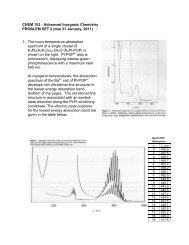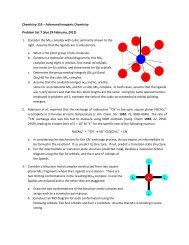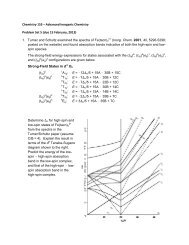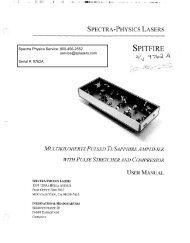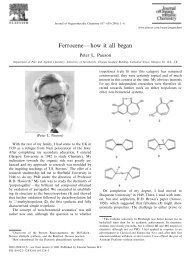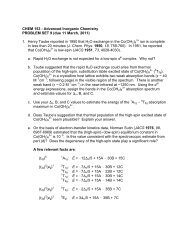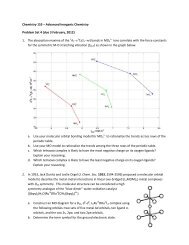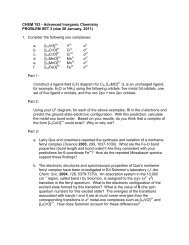Tsunami - Beckman Institute Laser Resource Center
Tsunami - Beckman Institute Laser Resource Center
Tsunami - Beckman Institute Laser Resource Center
You also want an ePaper? Increase the reach of your titles
YUMPU automatically turns print PDFs into web optimized ePapers that Google loves.
<strong>Laser</strong> Description<br />
-<br />
AOM<br />
OC<br />
n<br />
Fast<br />
Photodiode<br />
\<br />
\\ Beam Output<br />
'\ Splitter Brewster<br />
Window<br />
Window<br />
Model 3955<br />
AOM Driver Electronics<br />
Motorized<br />
Pump<br />
H R Beam Dump Optional<br />
Model 3930<br />
Lok-to-Clock Electronics<br />
Figure 3-4: Beam Path for <strong>Tsunami</strong> Model 39506 Picosecond Configuration.<br />
A10 Modulator (AOM)<br />
Wavelength Tuning Characteristics<br />
However, astigmatism still exists within the laser rod. Therefore, the pump<br />
beam must also be astigmatic for efficient coupling between the pump and<br />
intracavity beam. A concave focusing mirror used at the proper angle induces<br />
astigmatism in the pump beam that matches that of the <strong>Tsunami</strong><br />
cavity mode. The result is a laser with high conversion efficiency and good<br />
beam quality.<br />
The <strong>Tsunami</strong> acousto-optic modulator (AOM) ensures an 82 MHz nominal<br />
mode-locked operation at laser start-up. It also allows the laser to operate<br />
for extended periods without the dropouts or shut-downs associated with<br />
standard passive mode-locking systems. The AOM is at Brewster's angle<br />
and is driven by a regeneratively-derived rf signal.<br />
Because the Ti:sapphire rod is birefringent, unintempted tuning is<br />
achieved when the c-axis of the rod is aligned coplanar with the polarization<br />
of the electric field within the cavity. Since the Ti:sapphire rod and<br />
the birefringent filter plates or prism surfaces represent a total of ten<br />
Brewster's angle surfaces, the polarization within the cavity is largely determined<br />
by the orientation of these surfaces. Furthermore, cavity losses<br />
are minimized and tuning is optimized when all these surfaces are accurately<br />
aligned at Brewster's angle. The <strong>Tsunami</strong> laser uses a proprietary<br />
Ti:sapphire rod holder that orients the rod surfaces at Brewster's angle and<br />
allows the c-axis of the rod to be aligned coplanar to the electric field vector.<br />
This technique compensates for unavoidable errors in rod orientation<br />
that occur when the rod is cut and polished.



